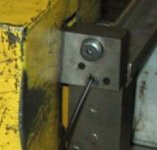Eric Nelson
Lifetime Supporting Member + Moderator
pstephens said:I wonder if I can exchange it?
Don't bother. What you bought is more appropriate for your application, because:
elevmike said:You wount be able to operate coils large relays or solinoids from the DC outputs, but you can operate almost anything from the Relay outputs.
Except a pulse train to a stepper motor. At least not for very long...
Instead of calling A-D to exchange you PLC, call them to order one of their stepper systems. Yes, they sell these now...
pstephens said:It seems that designers are always getting goaded into using them by their relative simplicity and low cost, and then paying the price in the form of missed steps, lack of torque at speed, and a host of other idiosyncrasies associated with an open-loop stepper system
I'm not a fan of steppers mostly for those reasons, but your budget kinda rules out a servo. Since you're not moving all that fast, you may want to try it first without an encoder. If you find it isn't repeatable, then adding an encoder will allow the PLC to make up for the missed steps, slippage, etc.
Basically, an open loop system simply instructs the stepper to move 'n' steps to move the wire the correct distance. Without the feedback of an encoder, the PLC doesn't know if the wire actually moved the correct distance, for whatever reason.
Open-Loop:
PLC: "Give me 60 inches of wire"
Response: "I'll try, but I won't make any promises"
Closed-Loop:
PLC: "Give me 60 inches of wire"
Response: "I gave you exactly 'x' inches of wire"
beerchug
-Eric
Last edited:




